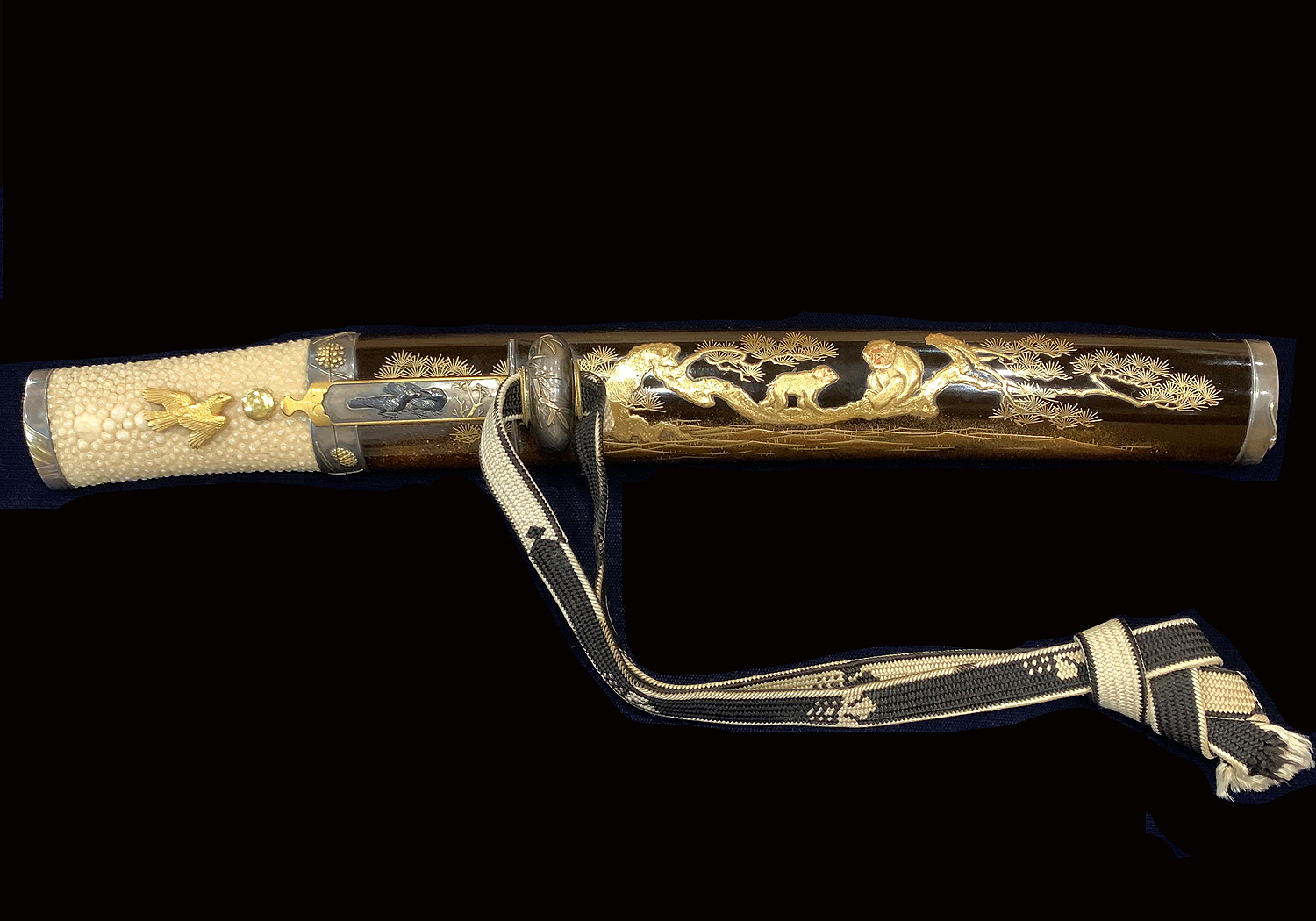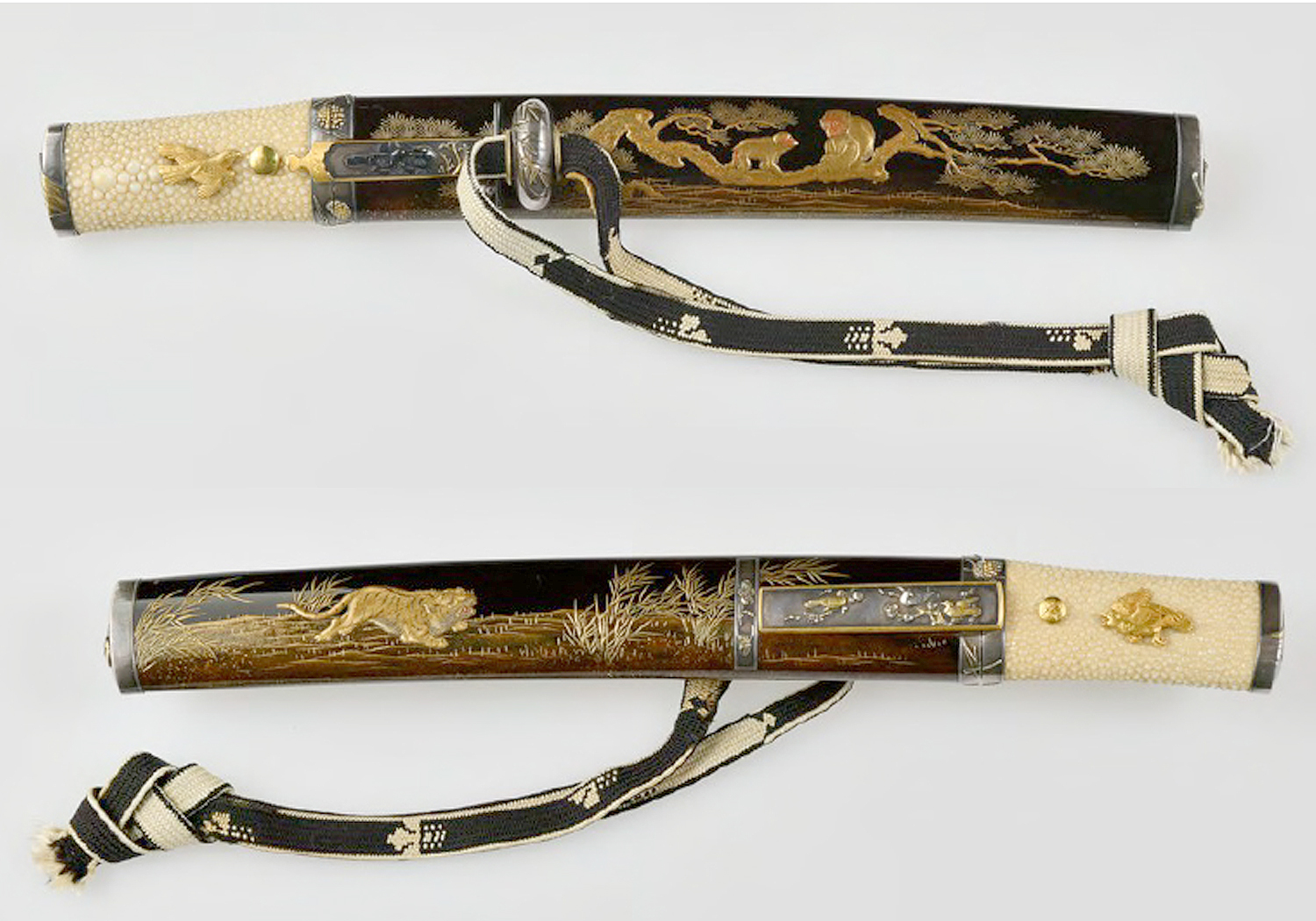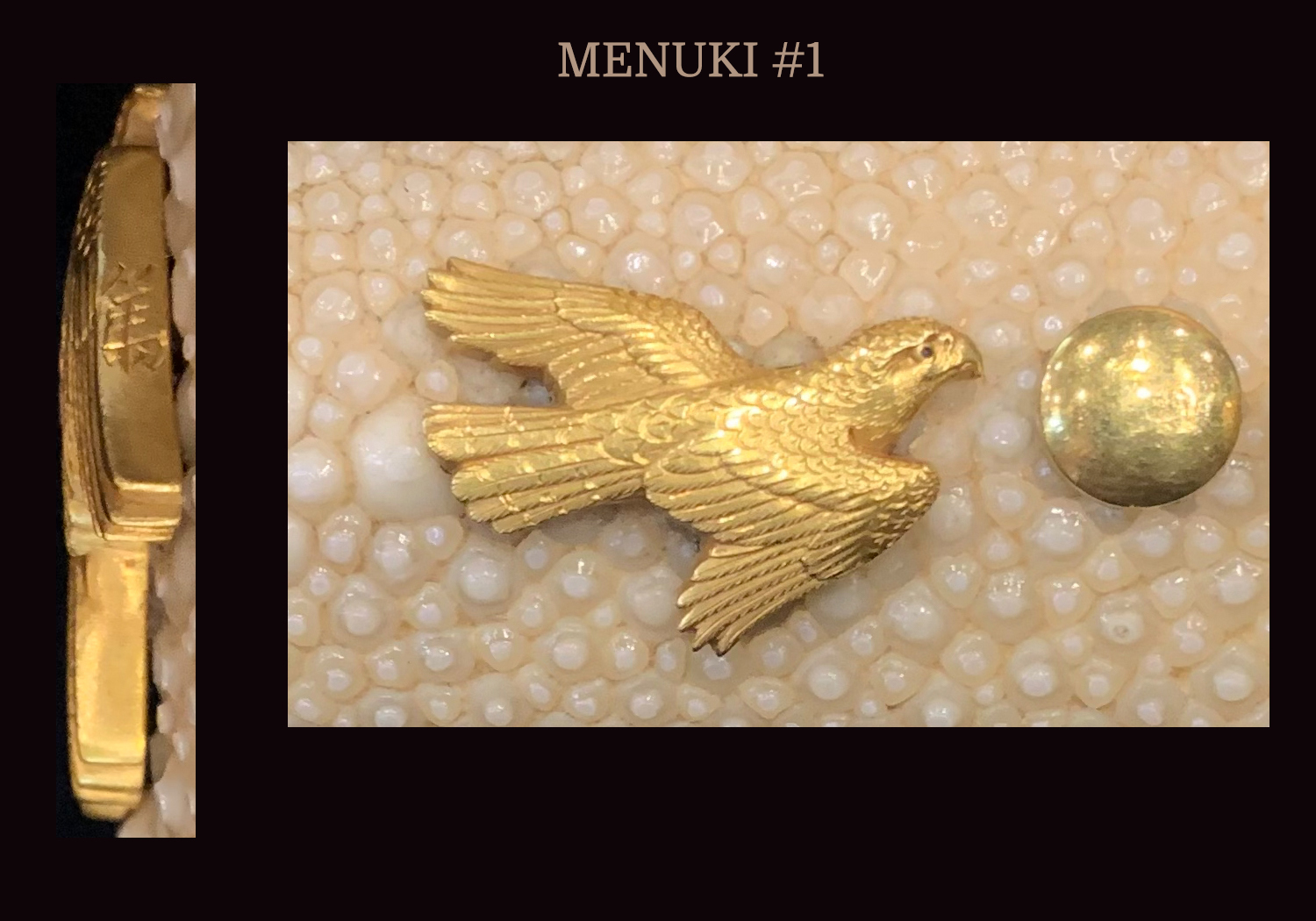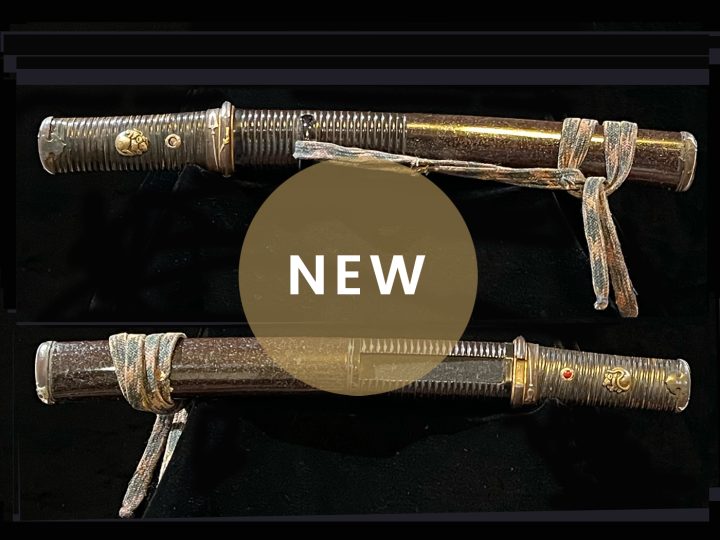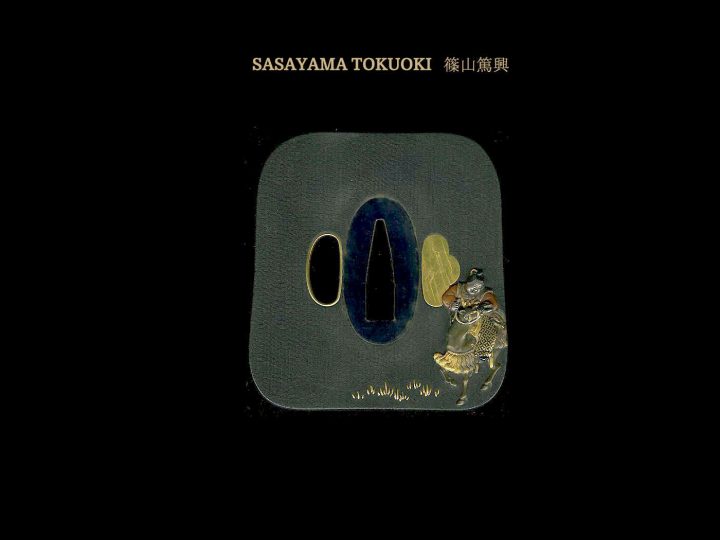
Tokuoki (篤興) was born on November 17th of Bunka 10 (1813) and he passed away on December 10 of Meiji 24 (1891) at the age of 79. He was the eldest son of Yahan Teigogai. He married the eldest daughter of Kawarabayashi Hideoki (川原林秀興) and became his student. He worked in Kyôto. After the Meiji Restoration, he was placed in charge of the government office for the encouragement of industry located in Kyôto.
Tokuoki’s (篤興) family names were Sasayama (篠山) and Fujiwara (藤原). His art names were Bunsen (文僊), Bunsendô (文僊堂), Hôsendô (方仙堂), Ikkôsai (一行斎), Manundô (万雲堂), Masaichirô (政一郎), Ôsumi (大泉), Sensai (仙斎), and Shôkatei (松花亭).
The translation of the setsume for the Jûyô-tôsô for this koshirae is as follows:
Jûyô-tôsô at the 66th shinsa held on December 15, 2020
Kuro-roiro makie-saya aikuchi-tantō-koshirae (⿊蝋⾊蒔絵鞘合⼝短⼑拵) – Aikuchi- tantō-koshirae featuring glossy black-lacquer saya with makie décor
Menuki, wari-kibata-mei: Toku – oki (篤・興)
Kozuka, kōgai, mei: Ikkōsai Tokuoki (⼀⾏斎篤興)
Sayanuri, mei: Nagata Shūsui + kaō (永⽥習⽔「花押)
Measurements:
Overall length 34.0 cm, overall sori 0.5 cm, tsuka length 8.8 cm, tsuka sori 0.2 cm, saya length 25.6 cm, saya sori 0.3 cm
Description:
Hinshitsu-keijō: Kashira depicting Mt. Fuji, of polished silver, in sukidashi-takabori relief and with gold suemon-zōganinlay, unsigned; menuki depicting hawks, of gold, in katachibori, with shakudō- zōgan inlay, signed via wari-kibata-mei as quoted above.
Mekugi depicting sun and full moon, of gold, in marugata, with takabori relief, unsigned; fuchi and koiguchi depictingpine needles and pine cones, of polished silver, in takabori relief and with gold suemon-zōgan inlay, unsigned; kozuka depicting plum three and three doves, of polished shibuichi, in takabori relief and with gold, silver, and shakudō-zōganinlay and iroe accents, reverse gilded, signed as quoted above.
Kōgai depicting crow couple, of polished shibuichi, in takabori relief with gold and shakudō-zōgan inlay and iroe accents, reverse gilded, signed as quoted above; kurigata depicting bamboo grass, of polished silver, in takabori and with gold suemon-zōgan inlay, unsigned; uragawara depicting cherries, of polished silver, in takabori and with gold suemon-zōgan inlay, unsigned; kojiri depicting three eggplants, of polished silver, in takabori and with gold suemon-zōgan inlay, unsigned;
Tsuka covered in white same; saya in glossy black-lacquer and with makie décor, signature of makie artist as quoted above; sageo of white and black kainokuchi braid with paulownia crest pattern.
Era:
End of Edo period
Explanation:
Sasayama Tokuoki (篠⼭篤興, 1813–1891) belonged to the renowned Ōtsuki (⼤⽉) School of Kyōto kinkō artists and hadstudied with Kawarabayashi Hideoki (川原林秀興, 1788–1851), who was the best student of master Ōtsuki Mitsuoki (⼤⽉光興, 1766–1834). At that time, the Ōtsuki School had given rise to many outstanding artists, e.g., Ōtsuki Mitsuhiro (⼤⽉光弘), Minayama Ōki (皆⼭応起), Tenkōdō Hidekuni (天光堂秀国), and Matsuo Gassan (松尾⽉⼭), and among them, Tokuoki was held in particularly high esteem. In Bunkyū two (⽂久,1862).
Tokuoki received orders for making the fittings of a sword worn by the Tokugawa Shōgun, for which he was rewarded with the honorary title of Ōsumi no Jō (⼤隅掾). The year after, in Bunkyū three (1863), he had the honor of makingsword fittings for Emperor Kōmei (孝明天皇, 1831–1867) and was given the art name Ikkōsai (⼀⾏斎) on this occasion. Tokuoki’s workmanship mostly follows b the style of the Ōtsuki School, which is picturesque motifs interpreted in takabori relief with iroe accents, but he made also much use of flush hira-zōgan, katakiri-bori, and other forms of decoration. Tokuoki’s forte were bold motifs, but which retain the classical elegance of Kyōto aesthetics, and his works are certainly of outstanding quality.
The real name of makie lacquer artist Nagata Shūsui (永⽥習⽔,1811–1875) was Kawaguchi Yūsuke (河⼝裕助) and he was one of the most representative masters of his craft from the Bakumatsu to the Meiji era. Shūsui was born in Bunkaeight (⽂化, 1811) in Kyōto, took over the Nagata family of makie artists, and had studied with Asano Yūshichi (浅野友七, ?–1860). In Kaei seven (嘉永, 1854), after the Imperial palace was destroyed in a fire, Shūsui decorated furniture from the Imperial collection with makie and later decorated Imperial furniture in Bunkyū two (1862) on the occasion of Princess Kazu (皇⼥和宮, 1846–1877) relocation to Edo. Apart from that, it is said that Shūsui excelled in the tea ceremony upon studying with the eleventh generation tea master Sen no Sōshitsu (千宗室, 1810–1877).
With the kashira depicting Mt. Fuji, the menuki two hawks, the the kojiri three eggplants, the theme of the koshirae can be understood as Hatsuyume (初夢), the first dream one has in the new year that would foretell the luck of the dreamer in the ensuing year. It is considered to be particularly good luck to dream of Mount Fuji, a hawk, and an eggplant, a belief has been in place since the early Edo period. In addition, fuchi and koiguchi depict pine needles and pine cones, which represent the New Year as well and therefore we have here an aikuchi-tantō-koshirae featuring a highly auspicious ornamentation. The fittings are decorated with gold elements, which are inlaid via suemon-zōgan, i.e., the décor is of solid gold and not only highlighted with gold iroe, which is a very luxurious and expensive approach.
The kozuka depicts three doves, likely a family, and the kōgai a harmonious crow couple that is sharing its prey. The makie décor of the scabbard depicts monkeys on an old pine and is very elaborately executed down to details, e.g., the pine bark, the fur of the monkeys, and the pine needles. Thus, we have here a gorgeous and highly auspicious koshirae whose fittings and makie décor were both executed by one of the then greatest artists in their respective fields.

